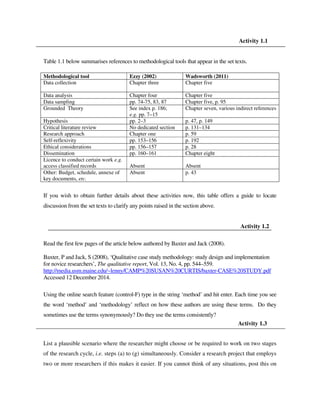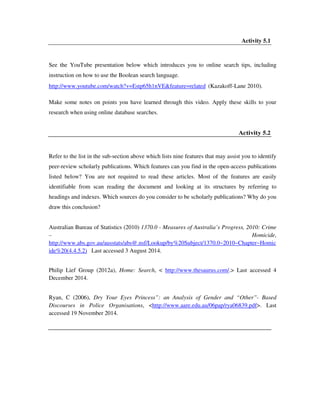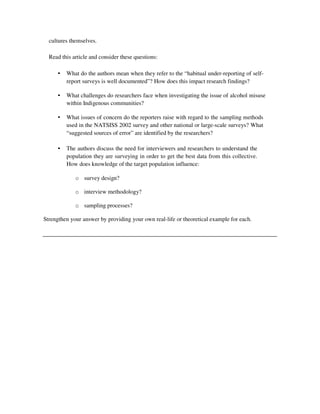The document is a tutorial draft on qualitative research methods for healthcare professionals, authored by Jay Jericho, covering key topics such as ethical considerations, methodological designs, and research proposal writing. It provides various activities to engage learners in reflecting on qualitative research practices and encourages discussion on ethical issues and research scenarios. The aim is to equip healthcare professionals with the knowledge and skills necessary to conduct qualitative research effectively.




![Blackboard to see if your peers agree that such a scenario is highly unlikely or impossible.
Activity 1.4
Blaxter et al. (2003, p.158) argue that:
The conduct of ethically informed social research should be a goal of all social researchers. Most commonly,
ethical issues are thought to arise predominantly with research designs that use qualitative methods of data
collection. This is because of the closer relationship between the researcher and the researched. Nevertheless,
all social research (whether using surveys, documents, interviews or computer-mediated communication)
gives rise to a range of ethical issues around privacy, informed consent, anonymity, secrecy, being truthful
[emphasis added] and the desirability of the research. It is important, therefore, that you are aware of these
issues and how you might respond to them.
You are a social researcher and your project aims to interview all female parliamentarians who
have served in the Australian Parliament for at least three years over the past decade as a member
of a party, not as an independent. It is imperative for you to gain the most accurate opinion about
whether these women believe that the majority of their male colleagues did not believe that
women in their party were suitable for senior party positions because of their gender. Which two
of the five ethical design considerations (highlighted in bold italics above) do you think are the
most important factors that you need to convince these women will be built into your
methodological design, and adhered to at all times? Explain why you regard these two as the most
important considerations insofar as they aid you to pursue your objective.
Activity 1.5
Why do we need special ethical guidelines for research in Indigenous communities?
Go to National Health and Medical Research (NHMRC) Council website at:
http://www.nhmrc.gov.au/_files_nhmrc/publications/attachments/e52.pdf
Last accessed 14 December 2014.
Review the report titled “Values and Ethics: Guidelines for Ethical Conduct in Aboriginal and
Torres Strait Islander Health Research.”
Explain in your own words what the following terms mean in the context of social research:
1. Reciprocity; 2. Respect; 3.Equality; 4. Responsibility; 5.Survival and protection;
6. Spirit and integrity.](https://image.slidesharecdn.com/qualitativeresearchstudyguide-161028201131/85/Qualitative-research-study-guide-5-320.jpg)


































![Section 6: Writing a research report and disseminating the findings 121
Reading 11.1
Read Tashiro and Mortenson (2006), “Translational research. How social psychology can
improve psychotherapy”, American psychologist, vol. 61, no. 9, pp. 959-966.
This reading provides details of the gap between research and practice and ways to use
translational research to close it.
Activity 11.1
Having reviewed Tashiro and Mortenson (2006) answer the following questions, synthesizing
discussion that occurs in the chapter sub-section above.
• Define in three to four sentences the term ‘translational research’.
• What are the five translational methods? Describe the major traits of each method.
• How do the authors suggest that translational research assists in the responses to mental
health issues?
• How might translational research bridge the science-practice gap?
Reading 11.2
Read Whiteman, E (2007), “Just Chatting”: Research Ethics and Cyberspace, International
Journal of Qualitative Methods, vol. 6, no. 2, pp. 1-8
This reading will be used in Activity 11.2.
Activity 11.2
Whiteman (2007) examines the issue of ethical data collection in the context of computer-
mediated communication.
Examine the above reading and then consider these questions:
• What does the author mean when she refers to ‘ethical creep’?
• The author states that in her research “the ethical dilemmas [she has] faced have been
in applying the [ethics] policy to the unique circumstances of doing research in
cyberspace, where traditional ethical guidelines related to consent/assent and
confidentiality are not automatically applicable”.](https://image.slidesharecdn.com/qualitativeresearchstudyguide-161028201131/85/Qualitative-research-study-guide-40-320.jpg)




